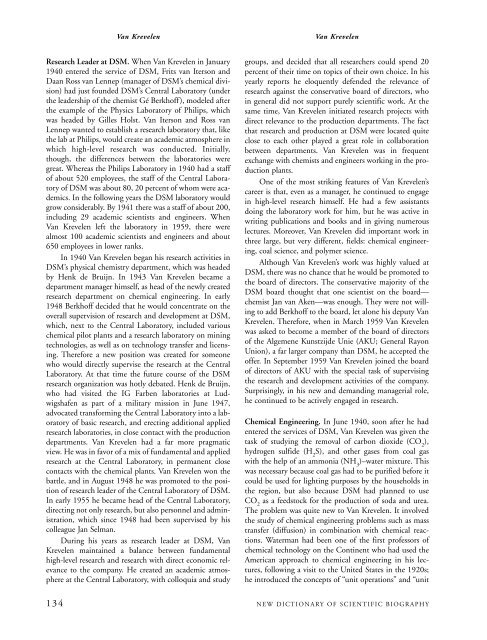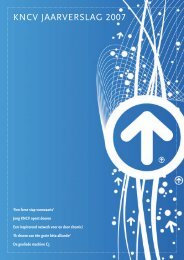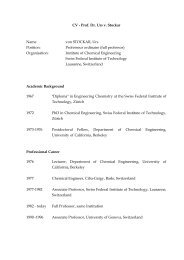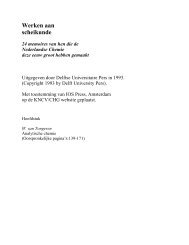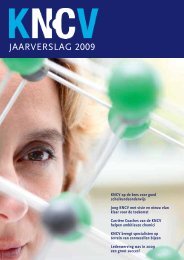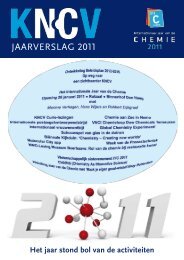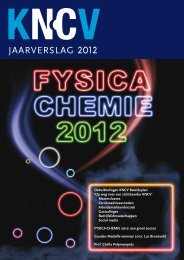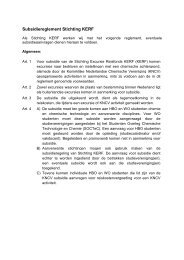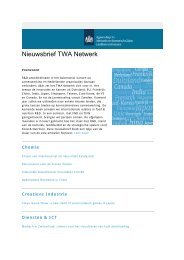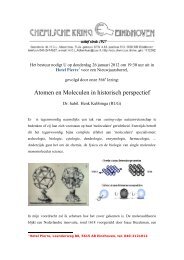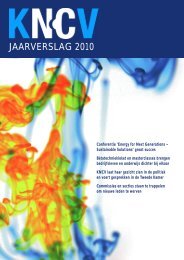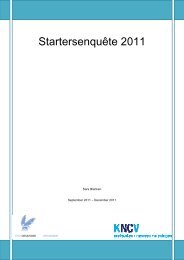VAN GOORLE, DAVID VAN KREVELEN, DIRK WILLEM (b. - KNCV
VAN GOORLE, DAVID VAN KREVELEN, DIRK WILLEM (b. - KNCV
VAN GOORLE, DAVID VAN KREVELEN, DIRK WILLEM (b. - KNCV
You also want an ePaper? Increase the reach of your titles
YUMPU automatically turns print PDFs into web optimized ePapers that Google loves.
ndsbv7_V 9/27/07 2:59 PM Page 134Van KrevelenVan KrevelenResearch Leader at DSM. When Van Krevelen in January1940 entered the service of DSM, Frits van Iterson andDaan Ross van Lennep (manager of DSM’s chemical division)had just founded DSM’s Central Laboratory (underthe leadership of the chemist Gé Berkhoff), modeled afterthe example of the Physics Laboratory of Philips, whichwas headed by Gilles Holst. Van Iterson and Ross vanLennep wanted to establish a research laboratory that, likethe lab at Philips, would create an academic atmosphere inwhich high-level research was conducted. Initially,though, the differences between the laboratories weregreat. Whereas the Philips Laboratory in 1940 had a staffof about 520 employees, the staff of the Central Laboratoryof DSM was about 80, 20 percent of whom were academics.In the following years the DSM laboratory wouldgrow considerably. By 1941 there was a staff of about 200,including 29 academic scientists and engineers. WhenVan Krevelen left the laboratory in 1959, there werealmost 100 academic scientists and engineers and about650 employees in lower ranks.In 1940 Van Krevelen began his research activities inDSM’s physical chemistry department, which was headedby Henk de Bruijn. In 1943 Van Krevelen became adepartment manager himself, as head of the newly createdresearch department on chemical engineering. In early1948 Berkhoff decided that he would concentrate on theoverall supervision of research and development at DSM,which, next to the Central Laboratory, included variouschemical pilot plants and a research laboratory on miningtechnologies, as well as on technology transfer and licensing.Therefore a new position was created for someonewho would directly supervise the research at the CentralLaboratory. At that time the future course of the DSMresearch organization was hotly debated. Henk de Bruijn,who had visited the IG Farben laboratories at Ludwigshafenas part of a military mission in June 1947,advocated transforming the Central Laboratory into a laboratoryof basic research, and erecting additional appliedresearch laboratories, in close contact with the productiondepartments. Van Krevelen had a far more pragmaticview. He was in favor of a mix of fundamental and appliedresearch at the Central Laboratory, in permanent closecontacts with the chemical plants. Van Krevelen won thebattle, and in August 1948 he was promoted to the positionof research leader of the Central Laboratory of DSM.In early 1955 he became head of the Central Laboratory,directing not only research, but also personnel and administration,which since 1948 had been supervised by hiscolleague Jan Selman.During his years as research leader at DSM, VanKrevelen maintained a balance between fundamentalhigh-level research and research with direct economic relevanceto the company. He created an academic atmosphereat the Central Laboratory, with colloquia and studygroups, and decided that all researchers could spend 20percent of their time on topics of their own choice. In hisyearly reports he eloquently defended the relevance ofresearch against the conservative board of directors, whoin general did not support purely scientific work. At thesame time, Van Krevelen initiated research projects withdirect relevance to the production departments. The factthat research and production at DSM were located quiteclose to each other played a great role in collaborationbetween departments. Van Krevelen was in frequentexchange with chemists and engineers working in the productionplants.One of the most striking features of Van Krevelen’scareer is that, even as a manager, he continued to engagein high-level research himself. He had a few assistantsdoing the laboratory work for him, but he was active inwriting publications and books and in giving numerouslectures. Moreover, Van Krevelen did important work inthree large, but very different, fields: chemical engineering,coal science, and polymer science.Although Van Krevelen’s work was highly valued atDSM, there was no chance that he would be promoted tothe board of directors. The conservative majority of theDSM board thought that one scientist on the board—chemist Jan van Aken—was enough. They were not willingto add Berkhoff to the board, let alone his deputy VanKrevelen. Therefore, when in March 1959 Van Krevelenwas asked to become a member of the board of directorsof the Algemene Kunstzijde Unie (AKU; General RayonUnion), a far larger company than DSM, he accepted theoffer. In September 1959 Van Krevelen joined the boardof directors of AKU with the special task of supervisingthe research and development activities of the company.Surprisingly, in his new and demanding managerial role,he continued to be actively engaged in research.Chemical Engineering. In June 1940, soon after he hadentered the services of DSM, Van Krevelen was given thetask of studying the removal of carbon dioxide (CO 2),hydrogen sulfide (H 2S), and other gases from coal gaswith the help of an ammonia (NH 3)–water mixture. Thiswas necessary because coal gas had to be purified before itcould be used for lighting purposes by the households inthe region, but also because DSM had planned to useCO 2as a feedstock for the production of soda and urea.The problem was quite new to Van Krevelen. It involvedthe study of chemical engineering problems such as masstransfer (diffusion) in combination with chemical reactions.Waterman had been one of the first professors ofchemical technology on the Continent who had used theAmerican approach to chemical engineering in his lectures,following a visit to the United States in the 1920s;he introduced the concepts of “unit operations” and “unit134 NEW DICTIONARY OF SCIENTIFIC BIOGRAPHY


